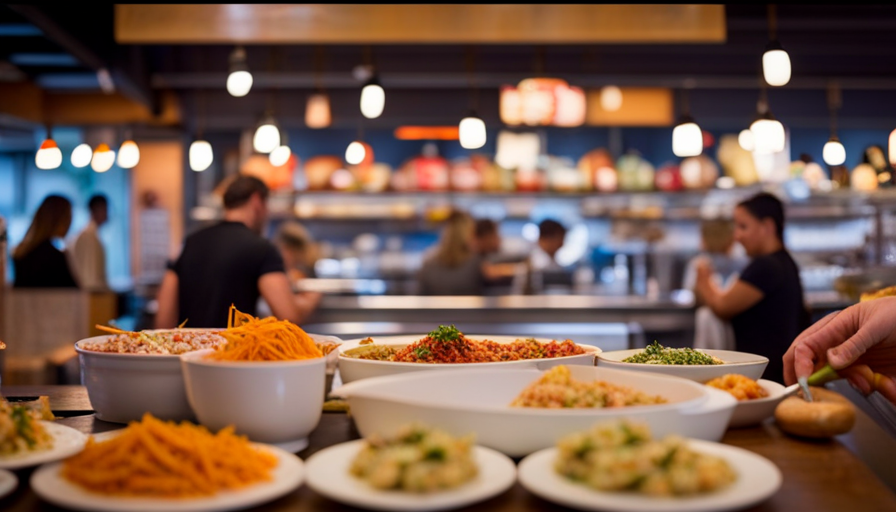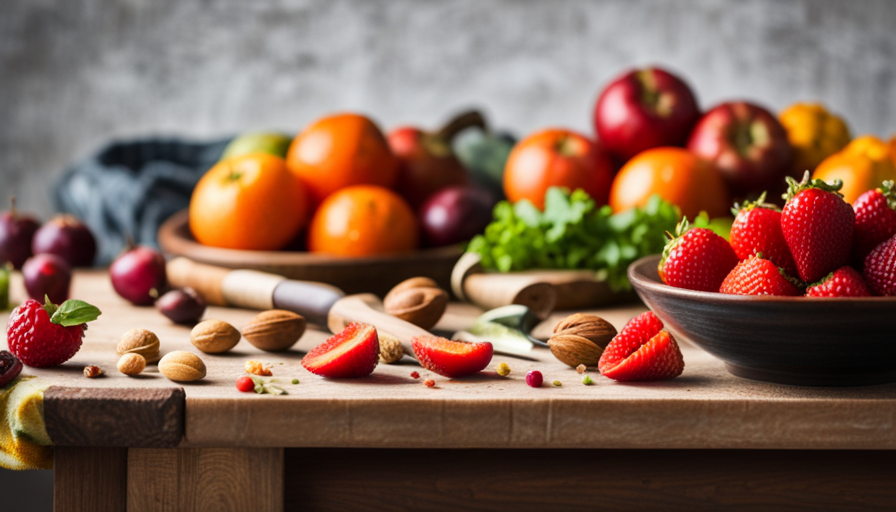Picture a plate overflowing with crisp, colorful fruits and vegetables, packed with essential nutrients and energy. It’s a sensory delight, a vibrant blend of flavors and textures. However, lurking beneath the surface, out of sight, is a hidden threat – the possibility of foodborne illness.
Just like a Trojan horse, raw food can carry harmful pathogens that invade our bodies, wreaking havoc on our health. But how does this seemingly wholesome fare become a breeding ground for illness?
In this article, we will delve into the world of raw food and explore the various ways it can give you food poisoning. From bacterial contamination to parasitic infections and viral illnesses, we will uncover the hidden dangers lurking in our seemingly innocent plates of raw goodness.
By understanding the risks, we can make informed choices to protect ourselves and our loved ones. So grab a seat at the table as we uncover the truth about raw food and its potential to harm.
Key Takeaways
- Raw food can carry harmful pathogens like bacteria and parasites that can cause food poisoning.
- Bacteria like Salmonella, E. coli, and Campylobacter can be found in raw meat, poultry, seafood, and eggs, leading to severe gastrointestinal symptoms.
- Parasitic infections like trichinosis caused by Trichinella can be contracted from undercooked meat and seafood, causing muscle pain, fever, and other health problems.
- Viral infections like norovirus and hepatitis A can be transmitted through raw shellfish and contaminated produce, emphasizing the importance of proper sourcing and washing practices.
The Dangers of Bacterial Contamination
You can get food poisoning from eating raw food when bacteria multiply and spread throughout your body, causing illness. Raw food, such as raw meat, poultry, seafood, and eggs, may contain harmful bacteria like Salmonella, E. coli, and Campylobacter. These bacteria can cause severe gastrointestinal symptoms, such as nausea, vomiting, diarrhea, and abdominal pain. In some cases, the symptoms can be life-threatening, especially for young children, older adults, and individuals with weakened immune systems.
Raw food can also harbor parasitic infections that can lead to food poisoning. One example is trichinosis, which is caused by the parasitic roundworm Trichinella. This parasite can be found in raw or undercooked pork, bear, and walrus meat. When consumed, the larvae of the parasite can travel to your muscles, where they can cause muscle pain, fever, swelling, and inflammation. In severe cases, trichinosis can lead to complications such as heart and lung problems.
It is important to handle and prepare raw food properly to minimize the risk of food poisoning. This includes washing hands thoroughly, separating raw food from ready-to-eat food, cooking raw meat and poultry to the appropriate temperature, and avoiding cross-contamination. By taking these precautions, you can reduce the likelihood of parasitic infections from raw food.
Transitioning into the subsequent section, it is also crucial to be aware of the risks associated with consuming raw food contaminated with parasites.
Parasitic Infections from Raw Food
Trichinosis is a parasitic infection that can be contracted from consuming undercooked meat, particularly pork. This infection is caused by the roundworm Trichinella spiralis, which can be present in the muscle tissue of infected animals.
Toxoplasmosis, on the other hand, is a parasitic infection that can be acquired from consuming raw or undercooked seafood, such as oysters and clams. The parasite responsible for toxoplasmosis is Toxoplasma gondii, which can contaminate the seafood through contaminated water sources.
Trichinosis from undercooked meat
If you don’t cook your meat thoroughly, you could end up with a case of trichinosis, which is like playing Russian roulette with your dinner.
Trichinosis is caused by a parasite called Trichinella spiralis, which can be found in undercooked pork, wild game, and other meats. To prevent trichinosis, it’s important to follow proper cooking temperature recommendations. Here are three key points to keep in mind:
-
Cook pork to an internal temperature of 145°F (63°C) and let it rest for at least three minutes before carving or consuming.
-
Freezing pork at -4°F (-20°C) for at least three weeks can kill the parasite.
-
Avoid consuming raw or undercooked wild game, as it may carry the parasite.
Trichinosis is just one of the many risks associated with consuming raw or undercooked meat.
Moving on to the next topic, let’s discuss toxoplasmosis from raw or undercooked seafood.
Toxoplasmosis from raw or undercooked seafood
When enjoying your seafood, make sure to cook it thoroughly to avoid the risk of contracting toxoplasmosis. Toxoplasmosis is a parasitic infection caused by the Toxoplasma gondii parasite found in raw or undercooked seafood, especially shellfish. Consuming contaminated seafood can lead to various symptoms such as fever, muscle aches, and swollen lymph nodes. In severe cases, it can cause damage to the brain, eyes, and other organs. Toxoplasmosis prevention is crucial, especially for pregnant women and individuals with weakened immune systems, as the infection can have severe consequences for the unborn child or those with compromised health. It is recommended to follow proper food safety practices, such as cooking seafood to an internal temperature of at least 145°F (63°C) and avoiding cross-contamination with raw seafood. By taking these precautions, you can reduce the risks of consuming raw seafood and protect yourself from toxoplasmosis.
Moving on to viral infections from raw food…
Viral Infections from Raw Food
To truly understand the dangers of consuming raw food, imagine yourself as a delicate butterfly fluttering near a tainted flower, unaware of the invisible viruses lurking on its petals. Viral outbreaks linked to raw food consumption have become a growing concern in recent years.
These foodborne viruses can cause a range of illnesses, from mild discomfort to severe complications. One of the most well-known viral infections associated with raw food is norovirus. This highly contagious virus can cause symptoms such as vomiting, diarrhea, and stomach cramps. It’s often found in raw shellfish, such as oysters, which can become contaminated with the virus if harvested from polluted waters.
Another foodborne virus that can be transmitted through raw food is hepatitis A. This virus primarily affects the liver and can lead to jaundice, fatigue, and abdominal pain. Raw produce, such as lettuce and berries, can become contaminated with hepatitis A if they come into contact with infected fecal matter during the growing or harvesting process.
Consuming raw food puts us at risk of these viral infections, as the viruses can survive on the surface of the food and enter our bodies when we consume it. It’s important to be aware of these risks and take precautions, such as washing fruits and vegetables thoroughly and ensuring that shellfish comes from reputable sources.
Understanding the potential consequences of consuming raw food is crucial in preventing foodborne illness symptoms and complications.
Foodborne Illness Symptoms and Complications
Imagine experiencing the debilitating symptoms and long-term complications that can arise from consuming contaminated food. Foodborne illnesses, often caused by consuming raw or undercooked foods, can have serious consequences on our health.
The symptoms of food poisoning can vary depending on the type of pathogen involved, but common ones include nausea, vomiting, diarrhea, abdominal pain, and fever. These symptoms can be severe and can last for several days, leading to dehydration and electrolyte imbalances. In some cases, foodborne illnesses can also result in more serious complications, such as kidney failure, reactive arthritis, and even death.
Preventing foodborne illnesses is crucial to avoid these long-term effects. Proper food handling, including thorough cooking of raw foods, is essential to kill any harmful bacteria or viruses present. Additionally, practicing good hygiene, such as washing hands and surfaces, can help prevent cross-contamination. It’s also important to be aware of high-risk foods, such as raw eggs, unpasteurized dairy products, and undercooked meats, and take extra precautions when consuming them.
Understanding the potential complications of food poisoning highlights the importance of food safety. Now, let’s delve into the high-risk groups for raw food poisoning and how they can protect themselves.
High-Risk Groups for Raw Food Poisoning
Vulnerable individuals, such as pregnant women and the elderly, face an increased risk of falling victim to the perils of consuming uncooked or contaminated ingredients, with potentially dire consequences. These high-risk groups are more susceptible to food poisoning due to their weakened immune systems, which can make it harder for their bodies to fight off harmful bacteria that may be present in raw food.
Additionally, pregnant women need to be especially cautious because certain types of foodborne illnesses, such as listeria, can have serious implications for both the mother and the unborn baby.
To prevent raw food poisoning in these high-risk groups, it is crucial to take necessary precautions. Firstly, it’s recommended to avoid consuming raw or undercooked animal products, such as eggs, meat, and seafood. These foods have a higher likelihood of carrying harmful bacteria like salmonella or E. coli.
Secondly, it’s important to practice safe food handling and storage techniques, such as washing hands thoroughly, keeping raw and cooked foods separate, and refrigerating perishable items promptly.
By following these prevention measures, vulnerable individuals can reduce their risk of contracting foodborne illnesses from raw food.
Transitioning into the subsequent section on prevention and safe handling of raw food, it’s essential to understand the importance of these practices in ensuring food safety.
Prevention and Safe Handling of Raw Food
Taking proper precautions and practicing safe handling techniques is crucial in ensuring the safety of the food you consume. Here are three key measures to prevent cross contamination and ensure proper cooking temperatures:
-
Separate: Keep raw foods, such as meat, poultry, and seafood, separate from ready-to-eat foods to avoid cross contamination. Use separate cutting boards, utensils, and storage containers for raw and cooked foods.
-
Cook: Cooking food to the correct temperature is essential for killing harmful bacteria. Use a food thermometer to ensure that meats, poultry, and seafood reach their recommended internal temperatures. For example, chicken should reach 165°F (74°C), while ground beef should reach 160°F (71°C).
-
Store: Properly storing raw foods is vital to prevent the growth of bacteria. Keep perishable foods refrigerated at temperatures below 40°F (4°C). Additionally, promptly refrigerate leftover cooked foods within two hours of cooking.
By following these guidelines, you can significantly reduce the risk of foodborne illnesses associated with raw food consumption. However, it’s important to note that safe handling techniques alone aren’t enough. The subsequent section will discuss the importance of food safety regulations in ensuring the overall safety of the food supply chain.
The Importance of Food Safety Regulations
In this discussion, I’ll be focusing on the importance of food safety regulations. Specifically, I’ll be discussing the FDA guidelines for handling raw food, restaurant inspections, and safety protocols.
The FDA guidelines are crucial in ensuring that raw food is handled properly to prevent foodborne illnesses. Regular restaurant inspections and the implementation of safety protocols are essential in maintaining high standards of food safety and protecting the health of consumers.
These measures are evidence-based and crucial in preventing the spread of foodborne illnesses and ensuring the overall safety of the food we consume.
FDA guidelines for handling raw food
When handling raw food, you have to be careful and follow FDA guidelines to avoid getting food poisoning, because one wrong move and it’s like unleashing a tornado of bacteria onto your plate. The FDA regulations are in place to ensure that food is handled properly from the moment it is harvested or produced until it reaches your plate. These guidelines include proper storage temperatures, separate cutting boards for raw meat and produce, thorough handwashing, and cooking food to the correct internal temperatures. Following these guidelines is crucial to prevent the growth and spread of harmful bacteria like Salmonella and E. coli that can cause foodborne illnesses. By adhering to these regulations, we can reduce the risk of foodborne illnesses and protect our health. Next, we will explore the importance of restaurant inspections and safety protocols in maintaining food safety.
Restaurant inspections and safety protocols
Make sure you’re fully aware of the importance of restaurant inspections and safety protocols to guarantee your dining experience is both enjoyable and safe.
Restaurant inspections play a crucial role in ensuring that food establishments meet the required standards for cleanliness and food safety. These inspections are conducted by health departments to assess various aspects of a restaurant, including proper food handling, storage, and preparation techniques. By regularly inspecting restaurants, health officials can identify and address potential hazards that may lead to foodborne illnesses.
Additionally, restaurants are required to follow safety protocols such as maintaining proper hygiene practices, implementing temperature controls, and regularly sanitizing surfaces. These protocols are designed to minimize the risk of cross-contamination and the growth of harmful bacteria. By adhering to strict safety guidelines, restaurants can provide a safe dining environment for their customers.
Moving on to common misconceptions about raw food safety…
Common Misconceptions about Raw Food Safety
I used to believe that natural foods were always safe to consume, but I soon learned that this is not always the case. There are several factors that can contribute to the contamination of raw foods, such as improper handling, cross-contamination, and the presence of harmful pathogens.
Additionally, I used to assume that organic foods were free from contamination, but research has shown that even organic foods can become contaminated if proper food safety practices are not followed.
It is important to understand these common misconceptions about raw food safety in order to make informed decisions about the foods we consume.
Believing that natural foods are always safe
Don’t be fooled by the misconception that all-natural foods are automatically risk-free – that’s a recipe for disaster! While it’s true that natural foods can provide many health benefits, assuming they are always safe is a dangerous myth. Let’s take a closer look at some common natural food myths and debunk the health claims associated with them.
| Natural Food Myth | Debunked Health Claim |
|---|---|
| Raw milk | Boosts immune system |
| Raw honey | Cures allergies |
| Raw eggs | Provides better nutrition |
Contrary to popular belief, raw milk does not boost the immune system. In fact, it can contain harmful bacteria like E. coli and Salmonella. Raw honey may have some health benefits, but it cannot cure allergies. Raw eggs may be a good source of protein, but they also carry the risk of Salmonella contamination.
Assuming that organic foods are free from contamination is another misconception that can lead to foodborne illnesses. Transitioning into the next section, it’s important to understand the potential risks associated with assuming organic foods are always safe.
Assuming that organic foods are free from contamination
Contrary to popular belief, assuming organic foods are always contamination-free can be a dangerous misconception. While organic foods are grown without the use of synthetic pesticides and fertilizers, they can still be contaminated with harmful bacteria such as E. coli and Salmonella.
In fact, a study published in the Journal of Food Protection found that organic leafy greens had a higher risk of bacterial contamination compared to conventionally grown ones. This misconception stems from the belief that organic farming methods inherently make the food safer. However, it is important to understand that organic foods are not immune to contamination.
That being said, organic foods do offer health benefits, such as higher nutrient content and lower levels of pesticide residues. Transitioning to the subsequent section, there are alternative options available for health-conscious individuals who want to avoid the risks associated with raw food consumption.
Alternatives to Raw Food for Health Conscious Individuals
Looking for healthier options? Try cooked food, it’s like a warm embrace for your body, providing nourishment without the risk of food poisoning. Cooked food offers numerous alternatives to raw food for health-conscious individuals.
Here are four nutrient-rich cooked meals that can help you maintain a balanced diet:
-
Steamed vegetables: Steaming vegetables helps retain their nutrients while enhancing their flavors. This cooking method also softens the vegetables, making them easier to digest and absorb.
-
Grilled lean meats: Grilling meats not only adds a delicious smoky flavor but also helps reduce fat content. Lean meats like chicken or fish are excellent sources of protein and essential nutrients.
-
Stir-fried dishes: Stir-frying is a quick and healthy cooking technique that preserves the nutrients in vegetables and proteins. It requires minimal oil, making it a great option for those watching their fat intake.
-
Baked fruits: Baking fruits can enhance their natural sweetness while maintaining their nutritional value. Enjoying baked apples or pears can be a satisfying and healthy dessert alternative.
By incorporating these nutrient-rich cooked meals into your diet, you can enjoy a wide variety of flavors and textures while ensuring your safety from foodborne illnesses. Transitioning into the subsequent section about ‘conclusion: balancing health and safety in food choices,’ it’s essential to consider both the nutritional benefits and potential risks associated with different food choices.
Conclusion: Balancing Health and Safety in Food Choices
Embrace the power of informed food choices, finding the perfect balance between nourishment and safety for your well-being. When it comes to raw food, it’s important to consider the potential risks of food poisoning. While raw food enthusiasts argue that it retains more nutrients and enzymes, there are certain safety concerns that can’t be ignored.
To ensure our health and safety, it’s crucial to explore alternatives to raw food. Cooking methods like steaming, boiling, and baking can help eliminate harmful bacteria and parasites present in raw ingredients. These alternatives not only reduce the risk of foodborne illnesses but also enhance the taste and texture of the food.
Balancing our taste preferences with ethical considerations is also significant. While raw food may align with certain ethical beliefs, it’s essential to remember that ethical choices can still be made while prioritizing food safety. Opting for organic produce, sourcing ingredients from local farmers, and choosing sustainable farming practices are all ways to make ethical food choices without compromising on safety.
It’s possible to strike a balance between health and safety in our food choices. By considering the potential risks of raw food and exploring alternatives, we can make informed decisions that prioritize both nourishment and well-being. With a thorough, scientific, and evidence-based approach, we can navigate the complex world of food choices and create a sustainable and safe diet.
Frequently Asked Questions
Are all types of raw food equally likely to cause food poisoning?
All types of raw food are not equally likely to cause food poisoning. Raw meat and unpasteurized dairy products are particularly risky. Raw meat can contain harmful bacteria like Salmonella and E. coli, which can cause severe illness.
Unpasteurized dairy products may be contaminated with pathogens such as Listeria, Campylobacter, or E. coli. These bacteria can cause food poisoning if consumed.
It’s important to handle and prepare raw food properly to reduce the risk of foodborne illnesses.
Are there any benefits to eating raw food that outweigh the risks of food poisoning?
There are potential benefits to eating raw food, such as increased nutrient intake and improved digestion. However, it’s important to consider the risks of food poisoning associated with raw food consumption.
Raw food, including fruits, vegetables, and meats, can be contaminated with harmful bacteria and pathogens that can cause illness. Therefore, it’s crucial to handle and prepare raw food properly to minimize the risk of foodborne illnesses.
Overall, the benefits of raw food must be weighed against the potential risks.
How can I ensure that the raw food I consume is safe and free from contamination?
To ensure the safety of raw food, proper handling is crucial. Start by washing hands thoroughly before and after handling raw food. Keep raw food separate from cooked items to prevent cross-contamination. Use separate cutting boards and utensils for raw and cooked foods. Store raw food in sealed containers to avoid contact with other items in the refrigerator. Proper cooking temperatures should also be followed to kill any potential pathogens. By following these practices, you can greatly reduce the risk of contamination and ensure the safety of raw food consumption.
Can cooking raw food eliminate the risk of food poisoning?
Cooking raw food can significantly reduce the risk of food poisoning. Proper cooking methods, such as heating food to the appropriate temperature, can kill harmful bacteria and other pathogens that may be present. This eliminates the potential for foodborne illnesses.
Additionally, cooking can enhance the nutritional value of certain foods, making them easier to digest and absorb. It’s important to follow safe cooking practices to ensure food safety and maximize the health benefits of the food we consume.
Are there any specific foods that are more prone to causing food poisoning when eaten raw?
When it comes to specific raw foods that are more prone to causing food poisoning, certain ones stand out.
Raw eggs, for example, have a higher risk of carrying Salmonella bacteria.
Raw seafood, such as oysters and sushi, can contain harmful bacteria and viruses like Vibrio and Norovirus.
Raw meats, especially ground beef, can harbor E. coli bacteria.
Consuming these foods can lead to common symptoms of food poisoning like nausea, vomiting, diarrhea, and abdominal pain.
What are the risks of food poisoning from raw chicken and how can it be prevented?
Raw chicken food poisoning timeline can range from 6-48 hours after consumption. The risk of contamination comes from improper handling and undercooking. Prevent it by cooking chicken to an internal temperature of 165°F, avoiding cross-contamination, and refrigerating leftovers promptly.
Conclusion
After delving into the dangers of bacterial contamination, parasitic infections, and viral infections from raw food, it becomes abundantly clear that raw food can indeed lead to food poisoning.
The symptoms and complications associated with foodborne illnesses are nothing to scoff at, and certain high-risk groups need to exercise extra caution.
While there are common misconceptions about raw food safety, it’s crucial to adhere to food safety regulations.
However, for health-conscious individuals seeking alternatives, it’s possible to strike a balance between health and safety in food choices.
Remember, choosing raw food is like walking a tightrope – one wrong step can lead to a fall.

















